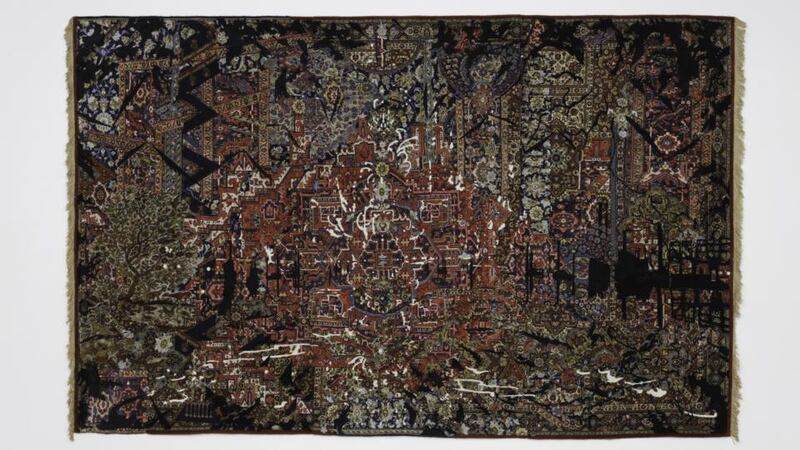The Skies Will Be Friendlier Then – Eoin Mc Hugh
Kerlin Gallery, Dublin
****


It may be something of a back-handed compliment, but Eoin Mc Hugh's The Skies Will Be Friendlier Then is really the exhibition he should have had at the Douglas Hyde Gallery last year. The show he actually put on there, Augury, was substantial and intermittently impressive, but came across as scattered and unresolved, as though he tried to do too much and never quite succeeded in tying it all together.
The Skies Will Be Friendlier Then is much more concentrated, although never predictable. It channels Mc Hugh's interest in the early history of psychoanalysis and the development of projective testing, typically the Rorschach inkblot test. The idea of such tests is that our perceptions are determined by our individual emotions, drives and neuroses and revealingly projected on to otherwise neutral imagery.
That idea of how we interpret what we see clearly appeals to Mc Hugh; the motif of experimental observation has been present in his work from the beginning. His NCAD graduation show in 2005 won Mc Hugh an enthusiastic following among commentators and collectors, who were wowed by his representational skills. Rather than employing those skills to produce straight realism, however, he developed a vein of retro surrealism close in mood to the work of contemporary Belgian painter Michaël Borremans.
In his deft drawings, Mc Hugh recalled an earlier era of scientific exploration, evoking yesterday’s utopias, with overtones of the uncanny and paranormal. Since his graduation, he has set about developing his own artistic vision and emerging from Borremans’s shadow.
On reflection, Augury was perhaps a misstep. The current show is much more convincing, even if Mc Hugh is still inclined to over-egg the pudding, cramming a surfeit of reference and allusion into each piece.
The central, richly imagined sculptural work, The Ground Itself Is Kind, Black Butter, takes its title from Seamus Heaney's Bogland (dedicated, incidentally, to the poet's friend, landscape painter TP Flanagan). Heaney mentions the skeleton of the great Irish elk and the blocks of preserved butter recovered from the bog.
In fact, the "enormous, flayed and headless beast" that Mc Hugh has created recalls the dark, burnished-looking bog people that Heaney also wrote about. The artist sees his creature as "part headless deer, part insect, part vagina dentata", a presence conjured up from the unconscious . . . bogland? Anyway, a nightmarish organism into which myriad fears and anxieties are packed. It's not mentioned, but HR Giger's creature for Ridley Scott's Alien is also certainly relevant.
The subject of another sculptural piece could have dreamed up the beast. Little Hans Nightlight refers to a patient of Freud's, a four-year-old who became agoraphobic and terrified after witnessing the collapse of a carthorse. In his eerie figure, Mc Hugh cleverly visualises the mental world of the child and the composite fantasy generated by his panic. The two works, beast and child, are distinct, but they complement each other perfectly.
Then there are two collaged oriental rugs. If no one thought of collaging rugs before, they should have, because they are intriguing objects. Mc Hugh refers to them, accurately, as consisting of “abstract patterns in conflict”.
Historically, oriental rugs are closely associated with the analyst’s office. Their abstract patterns make them ideal candidates for projective testing. We are inclined to read meanings into their rhythms and motifs. Mc Hugh complicates the issue, leading the eye into labyrinthine tangles of overlapping and cancelled pattern, providing ever more material for invention and interpretation.
The show takes its title from one of the rug collages. It's derived from a line in Wallace Stevens's poem Sunday Morning, in which a woman, instead of going to church, sits out in the sunlight, sipping coffee and reflecting on faith, religion and meaning. She concludes that the sense of reassurance and purpose offered is not borne out by the world around her.
In other words, we are projecting our own meanings on to the patterns in the carpet.
[ kerline.ieOpens in new window ]
Karl Burke (Gallery II & III); Futures 14: Helen G Blake, Adam Gibney, Aoibheann Greenan, Shane MacCarthy (Gallery I)
Royal Hibernian Academy, Gallagher Gallery, Dublin
**
It’s hard not to feel that Karl Burke’s exhibition, occupying two large spaces at the RHA, should have been better. Burke has shown himself to be sensitive in his response to architectural spaces, but it looks as if the RHA was a space too far.
He's not helped by the curiously underwhelming installation in the adjacent main gallery. It's the final instalment in the series of Futures, and the presentation suggests that it's running out of steam. The artists, especially Aoibheann Greenan, look as if they have something to offer, but it's just not framed or articulated properly.
Burke bravely sets out to engage with the gallery spaces using spare, linear steel constructions, with some low-key, accompanying repeat imagery. He is a musician as well as a visual artist, so one would expect a sense of rhythm and pace to carry over into the three dimensions, but it doesn’t.
What trips Burke up is scale, in the spatial sense. His sculptural elements look as if they were designed on an A4 sheet and then blown up to the gallery’s proportions. They just never feel right in the space.









